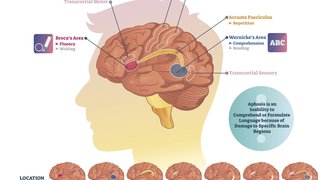
Concussions are scary, especially when your son or daughter is on the receiving end. It’s hard not to panic when your child gets hurt, especially after a hard hit during a high-impact sport.
Local parents are concerned about concussions and often ask my team questions such as these:
- How do I know if my child has had a concussion?
- Should all kids who get concussions see a doctor?
- Are high school and college concussion guidelines strong enough?
My team and I have worked for years on safety regulations, from the high school level all the way up to the pros. Let’s walk through the facts to help you better understand concussion symptoms, treatment of concussions, managing recovery and return to play, and your child’s long-term risk.
What are typical concussion symptoms?
Concussions can happen as the result of a blow, bump, or jolt to the head or body. When a concussion occurs, the brain is shaken and bounced around inside the skull.
These concussion symptoms can occur immediately, as well as after the injury:
- Headache or "pressure" in the head
- Nausea or vomiting
- Balance problems or dizziness
- Double or blurry vision
- Sensitivity to light or noise
- Feeling sluggish, hazy, or confused
- Concentration or memory problems
- Just “not feeling right” or “feeling down”
- Ringing in the ears
Many parents wonder if they should take their child to the emergency room for a concussion. Usually it’s not necessary. The typical treatment for a concussion is decreased noise, light, and stimulation – pretty much the opposite of a loud, bright, busy emergency room.
But there are situations in which a concussed person should go to the ER. If your child is experiencing any of these symptoms, head to the ER right away because a more serious injury likely has happened:
- Loss of consciousness, even for a short time (this only happens in about 10 percent of concussions)
- Neck pain
- Numbness or weakness anywhere in the body (particularly on one side)
- Drowsiness or inability to be awakened
- Irregular breathing
- Severe or worsening headaches, persistent vomiting, or seizures
- Typical concussion symptoms that do not improve or that worsen
For most concussions that happen during practice or a game, a trainer will evaluate the student-athlete. The trainer can then refer the child for care from a concussion specialist, such as those at UT Southwestern, who are also affiliated with our Texas Institute for Brain Injury and Repair. The athlete usually will be seen the next week, and a trip to the ER is unnecessary.
If your child gets a concussion during the school day, he or she should see the school nurse. If a concussion happens outside of school – the majority of concussive injuries in America are bicycle-related – it’s a judgment call for you as the parent or caregiver. If there’s no loss of consciousness or any of the other emergency symptoms listed above, you should bring the child home and let him or her rest.
When is it safe to return to sports after a concussion?
Like other injuries, it takes time for the brain to recover from a concussion. Depending on the severity of the head injury and the athlete’s history of concussions, the student-athlete may be unable to participate in full-contact practice or games for six weeks or longer.
Most student-athletes will be able to return to modified practice within a week or two.
- Kids in high school and younger typically return to play in three to four weeks, per CDC HEADS UP
- College-aged athletes, two to three weeks, per NCAA
- NFL or adult athletes, seven to eight days.
The younger the athlete, the longer it takes to fully recover from a concussion. That’s because of a process called myelination. Myelin is like an electrical cable around our nerve fibers that insulates and offers a buffer against impact. Myelination – the process of fully developing mature myelin – starts when we’re little and is usually completed by the time we leave college.
My child had a concussion – is the season over?
You hear it all the time – Joey had two concussions this year. Is his season over? Or, Suzy had three concussions during her high school career – can she play soccer in college?
Research is underway to determine the precise triggers between concussions and long-term health issues. What I pay attention to more than the number of concussions is the recovery interval between each injury. It’s very subjective, and we judge concussions in student-athletes on a case-by-case basis.
Here’s an example. After her first concussion, Suzy was back playing soccer in three weeks. After the second, she was back in seven weeks. It took Suzy three months to recover from concussion number three. The season is over for Suzy if I’m taking care of her. I’d probably let her play next year, but this season is over to avoid further injury.
In other words, whether your child’s season is over will depend on how long it takes your child to recover.
Are current concussion guidelines for student-athletes enough?
In Texas, students who participate in school-based sports programs must be released by a physician to return to play after suffering a concussion.
The Centers for Disease Control’s HEADS UP program outlines information to help parents understand when to allow kids to return to classes, practice, and games after suffering a concussion. The NCAA concussion guidelines are similar and are available for college student-athletes and parents. Both are appropriate for helping student-athletes fully recover in a healthy way.
The CDC and NCAA guidelines specify an incremental increase in activity for athletes who are recovering well. A full day after concussion symptoms completely go away, a student-athlete can slowly start to become active again. Often we’ll start with walking on a treadmill. If the student is symptom-free while walking, after a few days we’ll increase the intensity to a jog.
If symptoms return, we’ll ask the athlete to rest for the remainder of the day and start again the next day at the level of activity he or she could do without symptoms. It sounds like a long process to kids who want to get back to their sport, but student-athletes often can go through the process quickly and recover just fine.
These concussion guidelines are in place to help protect student-athletes short-term by keeping their head injuries from getting worse. More importantly, the guidelines can help decrease the risk for long-term ramifications from repeated head trauma that can happen when the brain is not allowed to fully recover.
Feel free to reach out to us if you have questions about concussions or how to approach the subject when it comes to your student-athlete. It’s always better to ask questions than to waste precious time worrying.










